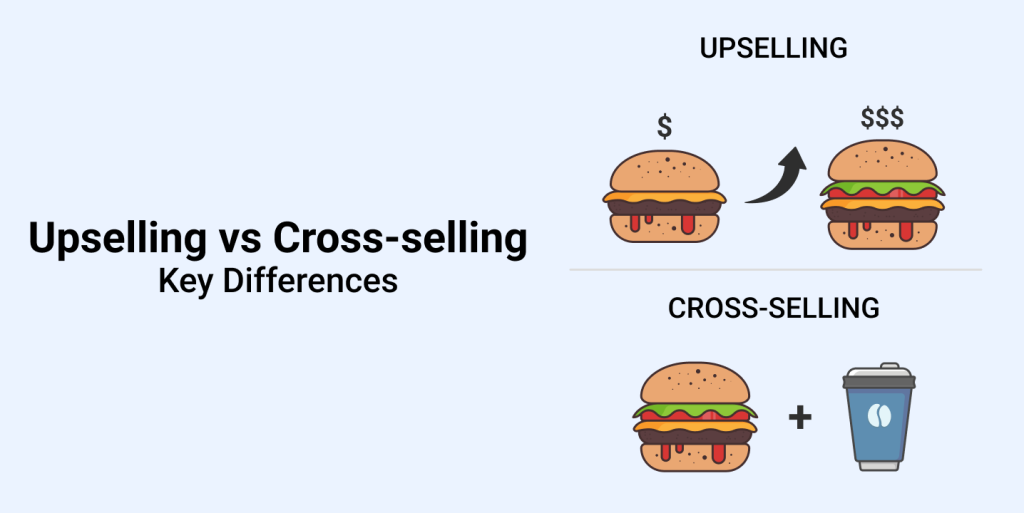Confused about upselling vs cross selling?
While they both may sound similar, they play very different roles in sales.
Understanding the difference between upselling and cross-selling effectively increases your store’s revenue. But what exactly are upselling and cross-selling? How do they differ, and more importantly, how can you use them effectively?
In this blog, we’ll break down the differences between upselling vs cross selling, explain how each can benefit your business, and provide tips on how to implement them effectively. Let’s get started.
What is Upselling?
Upselling is a sales technique used by sellers to encourage customers to buy a more expensive version of an item, upgrade, or add-on in an attempt to make a more profitable sale.
An example of upselling would be, if you are buying a coffee, upselling would occur if the seller asks, “Would you like to make it large for an extra dollar?” You’re still getting your coffee, but the seller is trying to increase your spend by offering a larger size.
What is Cross-selling?
Cross-selling is a sales technique where sellers recommend additional or related products to an existing customer.
An example of cross selling would be, imagine you’re ordering a burger at a restaurant. If the server suggests adding fries and a coffee to complete your meal, that’s cross-selling. They are offering you products that complement your original choice.
Difference Between Upselling and Cross selling
Upselling focuses on upgrading the single product the customer intends to buy, whereas cross-selling aims to increase the total number of products purchased.
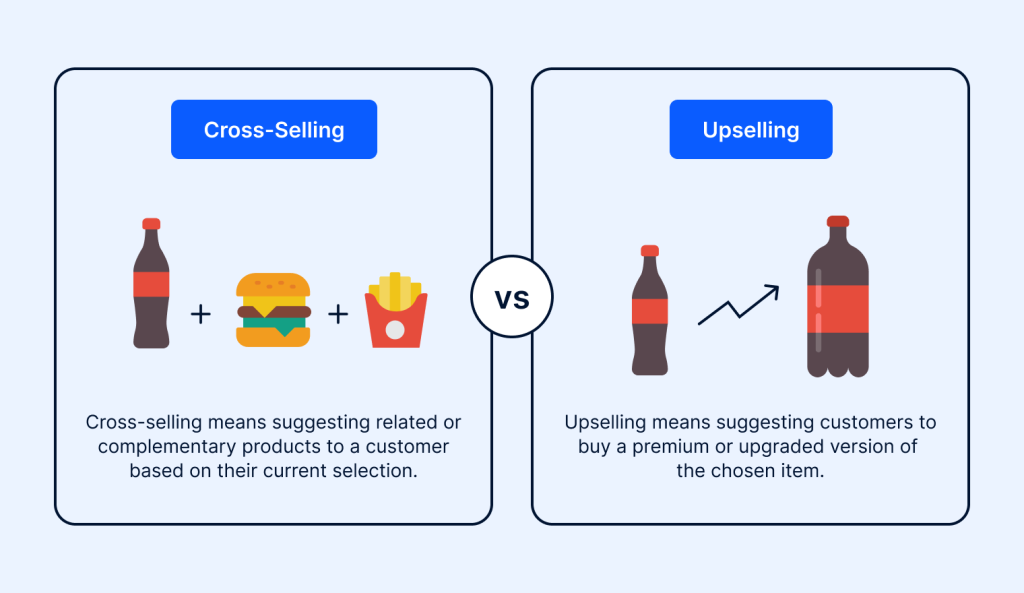
Both upselling vs cross selling aim to increase average order value and sales, they do so in different ways. Also, you might wonder, “Should I focus on one more than the other?
Eventually, cross selling vs upselling, it’s not about choosing one over the other; it’s about finding the right balance between them and using both in a correct way.
Comparison Table: Upselling vs Cross-Selling
| Feature | Upselling | Cross-Selling |
| Definition | Encouraging customers to buy a higher-end, more expensive version of a selected item. | Suggesting related or complementary products that go along with the item being purchased. |
| Objective | Increase the order value by selling a more premium version of the product. | Expand the order size by adding more products to the initial purchase. |
| Timing | Often presented during checkout or through follow-up offers after initial purchase. | Usually occurs during the customers’ shopping process, suggesting related items before finalizing their purchase. |
| Sales Technique | Often relies on showcasing the superior features and benefits of a premium product. | Relies on understanding customer needs and suggesting additional products that meet those needs. |
| Examples | Suggesting a basic model camera to a premium model with more features. | Suggesting memory card, and lens cleaning kit as add-ons to the main product, camera. |
Balancing Upselling and Cross-Selling
Now that you know what is upsell vs cross sell, let us see how to properly balance cross selling vs upselling. It’s about understanding the customer’s situation and offering products that truly make their shopping better.
- Understand the Situation: Not every shopping scenario is the same. Sometimes a customer is looking for something better than they originally planned (upselling), and other times, they might not know they need something until you suggest it (cross-selling).
- Meet Customer Needs: The key is to meet your customers where they are. If a customer seems hesitant about price, they might not be a great candidate for upselling but might appreciate cross-selling additional, lower-cost items that complement their purchase.
- Enhance Shopping Experience: Both strategies should aim to enhance the shopping experience. Upselling should feel like an upgrade, while cross-selling should feel like discovering something new and useful.
- Create Value: Ultimately, both techniques should create value for customers. This means offering upsells and cross-sells that are genuinely useful and relevant, not just attempts to get more money out of them.
After balancing both upsell and cross sell, knowing when to use each method is important for using them effectively.
When to Choose and Use Upselling
Here, we look at the best times to use upselling. Understand the signs that a customer is ready for an upgrade and how to make your upsell offer at just the right moment.
Use upselling when you understand what your customer likes
If your customer often buys items from a certain category, you can suggest better products from that same category. This makes the offer feel more tailored to them and can help you sell more.
When the customer shows interest in a product
It’s a good time to upsell when a customer is looking at a product. For example, if they are considering a basic smartphone, you might suggest a model with better features like a bigger screen, more storage, or a better camera.
When you offer exclusive deals
Offering special deals or limited-time offers on more expensive products can encourage customers to buy. A 10% discount on a higher model might get them interested in spending more.
When to Choose and Use Cross-Selling
This part delves into how to spot and take advantage of cross-sell opportunities. Learn the tactics for making these cross sell offers naturally during the buying process.
When you have broad product range
Cross-selling works best if your store has a variety of products that go well together. For example, if someone buys a paintbrush, suggesting they buy paints and canvas makes sense.
At the checkout
Adding upsell suggestions at the checkout when customers are already buying something can encourage them to grab a few more items. For instance, if they’re buying a book, you might suggest a bookmark at the checkout.
When there is a promotional campaign
When there’s a sale or promotional event, customers are more open to exploring deals and buying more. Showcasing products that go well with items they are already interested in can boost your sales.
Using these tips, you can decide when it’s best to upsell or cross-sell, making sure your suggestions are helpful and likely to lead to more sales for your store.
Where to Implement Upsell and Cross-Sell Offers
In this section, we explore where in the shopping process you can effectively put upsell and cross-sell strategies to work.
Checkout Page: Offer upsells or cross sells just before finalizing the purchase.
Cart Page: Suggest cross sell offers or upsell offers or cart add-ons in the cart page enhancing the likelihood of adding more products.
Product Pages: Display upsell or cross sell offers as frequently bought together items or offer small, relevant product add-ons in the product pages.
Post-Purchase Offers: Show your order bumps before or after the customer’s order to increase the conversion rate.
Upsell Popups: Use pop-ups to present higher-value items or bundles when customers show interest in a product.
Thank You Page: After a purchase, thank the customer and suggest additional products that could interest them based on their purchase history.
Real-world Examples of Upselling and Cross selling
Leading brands effectively increase their sales and AOV through strategic upselling and cross-selling. Let us look at some of the best examples of upselling and cross selling products in the eCommerce industry.
Upselling Examples in eCommerce
1. Apple Upselling example: When shopping for an iPhone on Apple’s website, customers are often recommended a premium version of the iPhone to increase their purchase value.
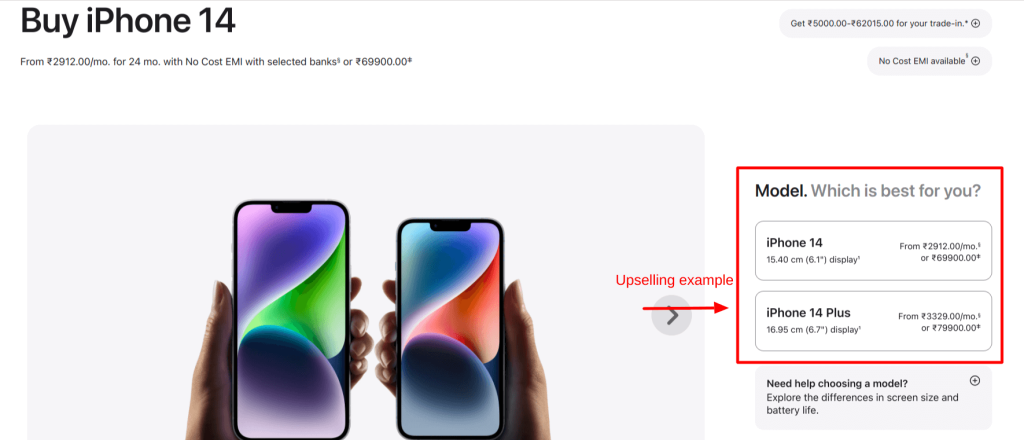
2. GoPro upselling example: When a customer looks at a basic model, GoPro’s website suggests considering a more advanced version that captures superior footage.
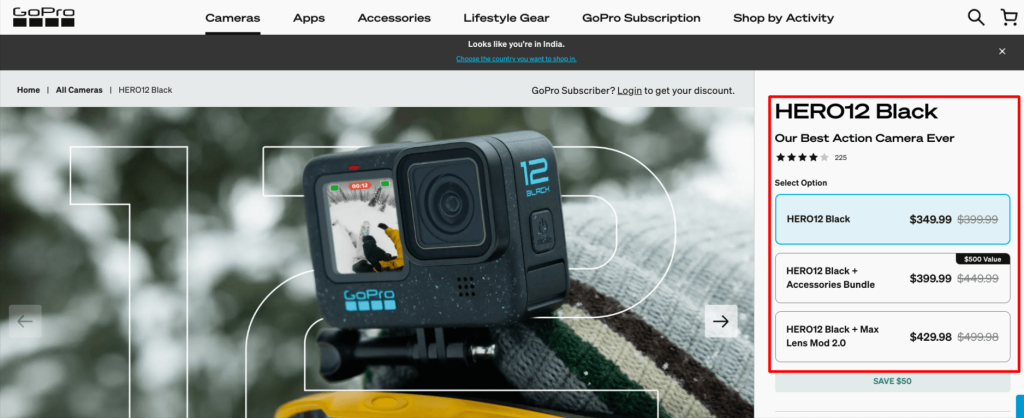
Cross-selling Examples in eCommerce
1. Sephora cross sell example: When a customer looks for a lipstick, Sephora suggests related cross sell products like micellar water, lip liner with an aim to increase customer’s purchase value.

2. FlipKart cross selling example: When a customer is shopping for a pair of shoes, cross selling would be suggesting relevant/additional products like shirts or sandals that go well with the main product.
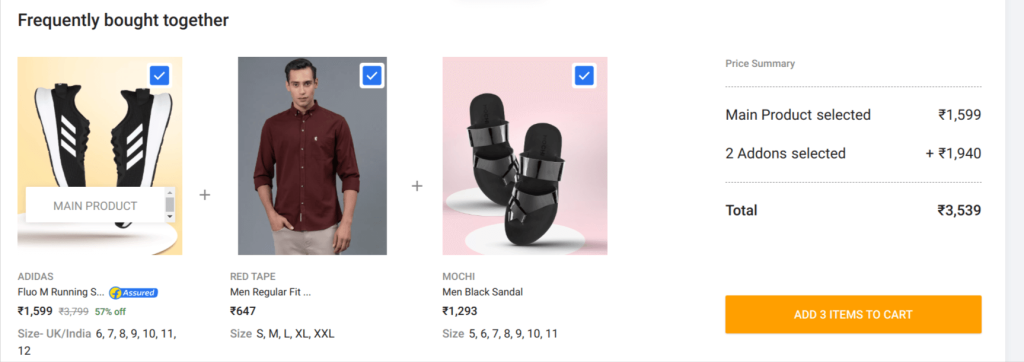
Get started with UpsellWP’s smart product suggestions and increase your revenue effortlessly.
Conclusion
Upselling and cross-selling really depends on your own business situation—like what kinds of products you sell, who your customers are, and the type of shopping experience you want to give.
By knowing how each strategy works and using them smartly, you can increase your sales while making your customers loyal.
Best Guides for Your WooCommerce Store
Upselling involves convincing customers to purchase a more expensive, upgraded, or premium version of a chosen item. Cross-selling, on the other hand, encourages buying additional products that complement the original item.
Cross-selling example: A phone case when buying a smartphone; a hair conditioner with shampoo.
Upselling example: Offering a larger size of a coffee; upgrading a flight to premium economy.
Expansion involves selling more of the same or similar products to an existing customer. Upselling means selling a more expensive version of a product. Cross-selling involves selling different, complementary products to an existing customer.
The four stages of upselling include identifying the opportunity, understanding the customer’s needs, presenting the benefits of an upgraded product, and closing the sale by making the upsell offer.
Cross-selling involves offering additional products that complement or enhance the main purchase. For example, suggesting a protective screen protector and earphones when a customer buys a new smartphone.

